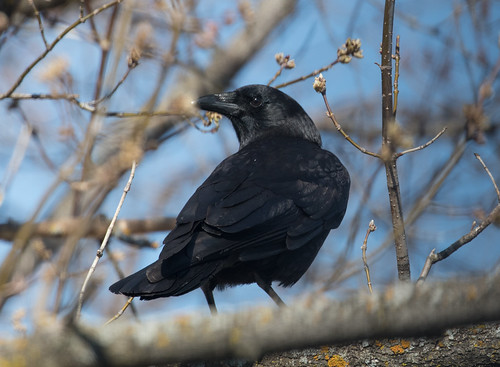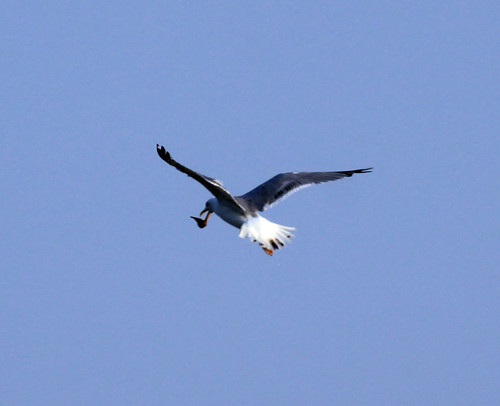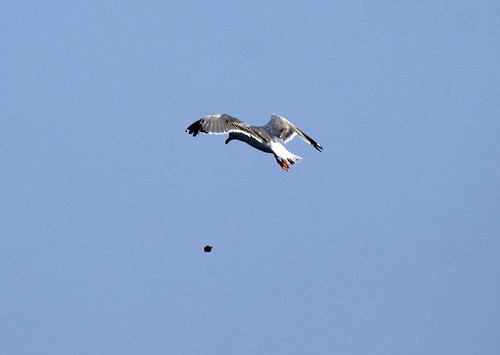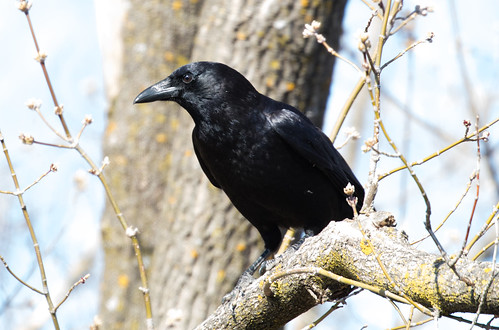Back in December, I got an interesting email from KAXE listener Steve Lorentz. He wrote:
I wanted to tell you about something I saw this fall. I observed a crow hovering in the wind about 250 feet above the ground. I watched it drop something from its beak and then dive to catch it after about a 40-foot fall. It appeared to be playing? The crow missed the catch on the fourth attempt and followed whatever it was playing with to the ground.Steve wrote back with a couple of additional details.
There was about a 15-mph wind out of the SW. Too bad I wasn’t able to ID whatever it was it was playing catch with. The image I got was of a young person playing catch with a ball but instead of throwing a ball into the air it was dropping it from above. I almost sensed the crow smiling as it dove and caught the object.One of the ways people distinguish crows from ravens is the generalization that crows are rather boring fliers, tending to fly directly from one place to another, literally “as the crow flies.” It’s their big relatives the ravens that we consider masters of complicated flight maneuvers. But crows are notorious mavericks and functionally illiterate, too—they haven’t read that they’re supposed to use their wings for simple, straight locomotion only. And like many other intelligent species, crows indeed spend time playing.
An injured crow I once rehabbed, named Icarus because someone shot him out of the sky, was skittish around me but forged a solid friendship with my toddler son Tommy. Tommy had a bouncy ball about the size of a basketball but much lighter, and he and Icarus often spent a half hour or longer playing catch. Tommy would pick up the ball and toss it to Icarus. Being just over 1 year old, Tommy’s toss was low to the floor to begin with and always ended on a roll. Icarus couldn’t catch it, but he’d position himself so as the ball got near, he’d smack it with his beak, rolling it straight back to Tommy. That was in the 1980s, long before digital photography—it’s one of the many things involving birds or my children that I wish I could have videotaped, or at the very least photographed. This game and Tommy’s and Icarus’s friendship were truly adorable.
For humans and other intelligent species, play can keep our powers of observation and reflexes sharp while exercising our minds. Often there is an added bonus—some forms of play can end up with a practical result. I’ve watched Herring Gulls on the East Coast flying up high while carrying various shelled animals.
They suddenly drop the shell to the ground, especially above rocks or low-traffic roads. Then they fly down to see what happened—if they cracked it open, they start feeding on the animal within. If they didn’t, they carry it aloft to drop again.
How did Herring Gulls figure this out? Did one uniquely philosophical bird long ago reason through that hitting the ground from high up would break the shell? Had one been carrying a shelled animal from one place to another, and when it accidentally dropped, discovered that hitting the hard ground opened the shell? Or did gulls start out simply playing, as Steve’s crow was doing, and thereby learned a cool trick?
We don’t know if the crow Steve observed was carrying something edible or not. Catching items in flight could be useful when tiny birds or large insects are winging by, so practicing these maneuvers might someday help that crow get an interesting meal. Meanwhile, that aerial game may well have been nourishing the bird’s spirit. Watching it certainly seems to have nourished Steve’s spirit. As he notes, “You can see interesting birding at all location as you go about your day.” When we keep our eyes and hearts open, the world is a fascinating place. One could do worse than be a watcher of birds.



